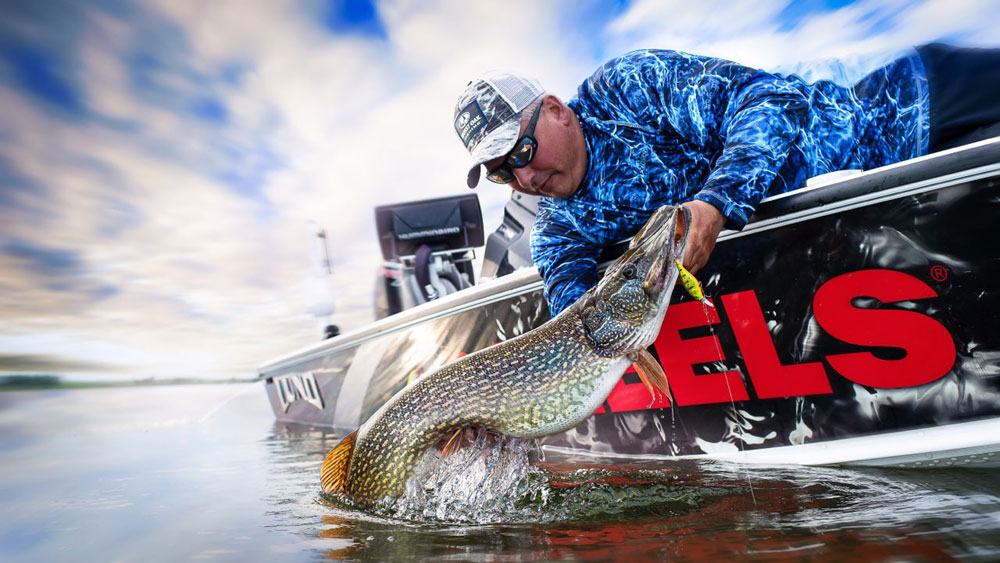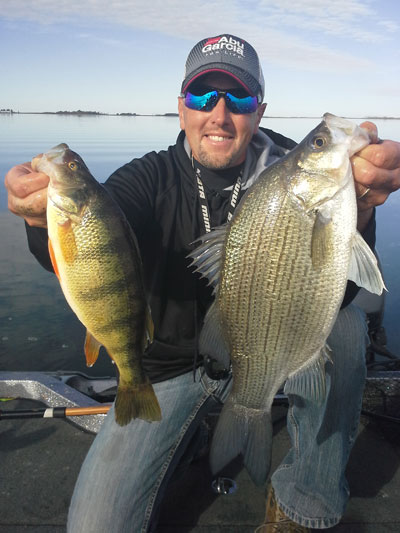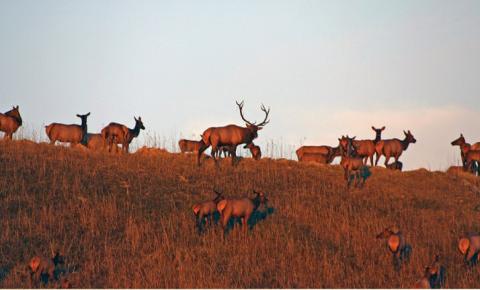provided by John E. Phillips
Mossy Oak Pro Johnnie Candle, from Devils Lake, North Dakota, has been a walleye tournament fisherman since 1994. He won the 2010 World Walleye Championship and in a normal year, would fish 6-10 walleye tournaments held all over the country. Candle also guides on Devils Lake as a professional angler. This week he shares information with us on spring fishing for walleyes.

As I’ve mentioned earlier, I don't start fishing until mid-May when I know that the ice has melted, and the shallow water has warmed up. Here, on Devils Lake where I live and guide, I'll be looking for walleyes in shallow bays off the main lake. The main body of water in the lake stays pretty cold until well into the summer, but the shallow bays with their dark, muddy bottoms that are lined with vegetation tend to warm up quicker than any other parts of the lake. Since the warm water attracts bait fish, I start off fishing with lures horizontally. We'll be fishing in skinny water that only may be 1-1/2 to 2 feet deep. Therefore, vertical jigging, like I do in the wintertime, isn’t practical. I'll be casting numbers of light jigs with soft-plastic bodies that I can reel in just under the surface. I'll be using shallow suspending jerkbaits like bass fishermen do. These lures can be cranked down and paused, so I can twitch them and keep them a certain depth throughout the entire retreat. I like to fish these jerkbaits when the water is still cool, which means less than 50 degrees. I've learned that when the water is 50 degrees or more, those jerkbaits still will catch fish, but not as many fish as they do when the water is 50 degrees or lower.
 When I first start fishing in mid-May, the first thing I’ll notice is that we're catching larger fish than we have before the water’s warmed up. The walleye will average 3-5 pounds after those first two weeks in May and throughout most of the late spring. As the water gets hotter, the bigger fish seem to leave the shallow water for a period of time, usually until the weeds start to grow - most often, for the last two or three weeks at the end of May and the first of June. That’s when we’re catching really big walleye that may weigh as much as 7 or 8 pounds. If you hit the right spot during that time with two anglers, you often may catch 50 or 60 walleyes in one day. Those kinds of days happen fairly often here on Devils Lake where I guide. Although the anglers can only keep five walleyes per person, they can catch and release all the walleyes they want.
When I first start fishing in mid-May, the first thing I’ll notice is that we're catching larger fish than we have before the water’s warmed up. The walleye will average 3-5 pounds after those first two weeks in May and throughout most of the late spring. As the water gets hotter, the bigger fish seem to leave the shallow water for a period of time, usually until the weeds start to grow - most often, for the last two or three weeks at the end of May and the first of June. That’s when we’re catching really big walleye that may weigh as much as 7 or 8 pounds. If you hit the right spot during that time with two anglers, you often may catch 50 or 60 walleyes in one day. Those kinds of days happen fairly often here on Devils Lake where I guide. Although the anglers can only keep five walleyes per person, they can catch and release all the walleyes they want.
When the water temperature reaches about 60 degrees, the bigger fish will pull out of the shallow water and start swimming to the 10-12 foot deep water. Once the weeds start to grow, the walleyes will do big U-turns and go back to the shallow-water weeds. Around the 4th of July, my anglers and me will move back into the shallow water and fish around those shallow weeds to start catching walleyes there all over again. When I move back into the shallow water, I’ll begin fishing shallow-running crankbaits that will run over the tops of the weeds and big swimbaits, rattle tail style lures and a variety of soft-plastic baits with a lot of action with a 1/8-ounce or a 3/8-ounce jig head. What I like about these types of lures is that all I have to do is cast them out and reel them in on the tops and the edges of the weeds. The colors that seem to produce best are yellow perch and any type of white lure.
Although I’ve been discussing mainly fishing for walleyes, we have other fish in Devils Lake that we can catch, including northern pike, white bass, black crappie and yellow perch. We don’t have any bluegills, large bass, smallmouth bass, spotted bass, catfish or carp. The good news is, all the other fish hang out and feed on the same baits that walleyes do. We catch numbers of the other species of fish when we’re fishing for walleyes. Some days we'll catch three northern pikes for every walleye we catch. And, I know you're going to think I'm lying, but we have had days when my party and I have caught a different species of fish on every cast we’ve made for 5 hours. That produces an awful lot of bent rods and smiling faces every day we fish from the second week in May until ice-up.
To see the kind of fish that Candle is producing and to get in touch with him, go to www.johnniecandle.com, or call him at 701-371-9431.




























